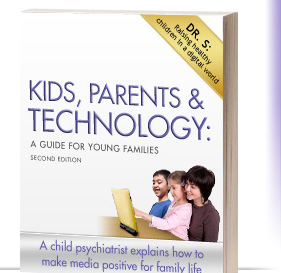Part 1: SETUP AND QUICK START GUIDE
Chapter 1: An Extreme Makeover—Appreciate That You Are Wiring Your Children’s Brains
FACT SHEET: Media Use is exploding among youngsters:
Kaiser Family Foundation CHILD SURVEY 2010 2010 Generation M2: Media in the Lives of 8- to 18-Year-Olds
MEDIA = TV, music, computer, cell phone, gaming, texting , reading magazines
- Kids 8-18 CONSUMPTION: 63 hr/w on media including texting; over 85 hours /w if count multitasking; Light users 17% <31 hrs/ w ; heavy users 21% >132 hrs/w
- CONSUMPTION Prior to age 11-14 56 hrs/w
- Media: 30 hrs/w TV, music/audio 18 hrs/w, computers 11 hrs/w, texting 10 HRS/W, movies + print 7 hrs/w
- TV – 30 hrs/w 25 hrs/w whites, 42 hrs/w non-whites, difference is growing. 2/3 during meals, ½ all the time, 70% in BR. Watching now 40% on Internet, mobile devices
- Video games: 1/3 have video game in room, boys 10 h/w
- Reason for increases: Increasing with age, as new devices and services keep coming: portable devices , multitasking and texting
- Multitasking: 40% ‘most of the time’
- Texting(not counted here) additional 10 hrs/w
- Social Networking – 2 ½ hrs/w, ¾ have a profile; gaming 2 hrs/w
- About ½ have rules or limits, but even then, kids spend 48 hours a week with media
- School: Lower grades Cs or lower – heavy users ½, light users 1/3, ½ use media doing homework
- Gender: Girls: more social networking and reading, boys more gaming
Disney PARENT SURVEY 2008
http://www.wired.com/geekdad/2008/12/disney-survey-s/ - 48% of respondents aged 25-34 said their children began using a cell phone at age 5 or younger
- Despite 80% stating they were worried about online safety, 26% said their children, age 8 or younger were allowed internet access while alone
- 81% provided their children a personal e-mail address to register for a site online, 69% have uploaded a photo and 59% have used chat/IM
In general, recent studies in pediatric scientific journals suggest that media consumption among children is pervasive and that early childhood patterns persist into later years. A recent comprehensive study of over 1000 American children zero to six years old, a team of University of Texas scientists headed by Dr. Elizabeth A. Vanderwater, found that on a typical day, “75 percent watched television and 32 percent watched videos/DVDs, for approximately one hour and twenty minutes, on average. (Pediatrics. 2007 May; 119(5):e1006-15; also see Measuring Children’s Media Use in the Digital Age: Issues and Challenges.)
Scientists also reported (Pediatrics. 2006 Feb;117(2):e181-91) that the more time they spent watching TV, the less time children spent doing other things with family members, homework (seven- to twelve-year-olds) and creative play (younger than five years).
New media are also making inroads with young children: 27 percent of five- to six-year-olds used a computer (for fifty minutes on average) on a typical day. Many young children (one fifth of zero to two-year-olds and more than one third of three- to six-year-olds) also have a television in their bedroom. The most common reason given was that it frees up other televisions in the house so that other family members can watch their own shows (54%). The majority of children aged three to six fell within the American Academy of Pediatrics guidelines, but 70 percent of zero to two-year-olds did not.” These guidelines specify no screen time at all for babies younger than two, and a maximum of two hours a day for older kids.
High users of media at young ages are likely to remain high users when older (J Adolesc. 2006 Jun;29(3):333-49. Epub 2005 Oct 21).
Adolescent gamers (both genders) playing video games without parents or friends spent less time with family and friends in other activities and about a third less time reading and doing homework (Arch Pediatr Adolesc Med. 2007 Jul;161(7):684-9).
Dr. Elizabeth Vanderwater and her colleagues report in another study that the more time they spent watching TV, the less time children spent doing other things with family members, homework (seven- to twelve-year-olds) and creative play (younger than five years). (Pediatrics. 2006 Feb;117(2):e181-91).
Believe it or not, you are actually gradually programming circuits in your child’s brain every day. Louis Cozolino offers us a superb and readable work. The Neuroscience of Human Relationships (W.W. Norton & Company, 2006, ISBN 10-0-393-70454-8) is a must read summary of the brain mechanisms that underlie human experience.



